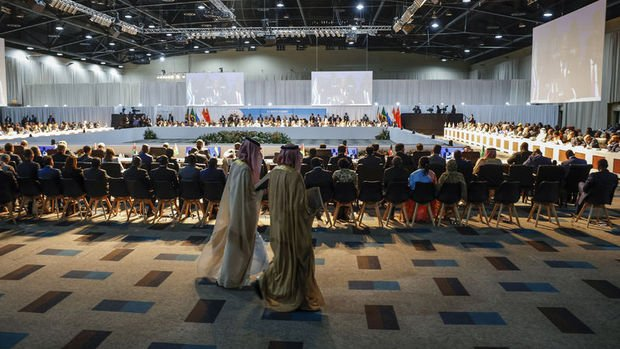Economic power of oil giant countries accepted to BRICS
The BRICS group is entering its first expansion process since 2010 and aims to increase its international influence against the West by including six countries, including Saudi Arabia, Iran, the United Arab Emirates (UAE) and Egypt, which are the largest economies in the Middle East region and are rich in oil. The oil giants of the Middle East that were accepted to the BRICS have an economic power of approximately $2.5 trillion. The BRICS countries, consisting of Brazil, Russia, India, China and South Africa, accepted the membership requests of Saudi Arabia, Iran, the UAE, Egypt, Ethiopia and Argentina at the 15th Leaders’ Summit held in Johannesburg, South Africa and ended on August 24, in order to accelerate their steps towards reestablishing the world order and increasing their global influence. South African leader Cyril Ramaphosa, who hosted the BRICS Leaders’ Summit, announced that the new countries would become members of the bloc as of January 1, 2024. With this decision, the number of BRICS members will increase from 5 to 11 in the new year. It is anticipated that the membership of the countries with the largest economies in the Middle East region such as Saudi Arabia, Iran, the UAE and Egypt, and the largest oil and natural gas reserves in the world, could also increase the political and economic power of BRICS in the international arena at a time when the importance of energy in the world is increasing. Saudi Arabia Among the 6 countries invited to BRICS, one of the most notable was Saudi Arabia, the world's largest oil exporter. Saudi Arabia, which produces approximately 10 million barrels of crude oil per day, exports 7 million barrels of this amount. According to data published by the General Statistics Administration of Saudi Arabia in February, the Riyadh administration, which earned $326 billion in revenue from oil exports in 2022, sells the most oil to Asian countries such as China, Japan, South Korea and India. Experts speaking to the regional and international press indicate that the Riyadh administration, which has recently taken steps to get closer to China and Russia, will be able to achieve its goals of diversifying its economy by joining BRICS. According to the news of Saudi Arabia's "Al-Iqtisadiye" newspaper, the country's total gross domestic product (GDP) for 2022 reached 4.16 trillion riyals ($1.11 trillion) for the first time. In the 2023 budget announced by the Saudi Arabian Ministry of Finance, the total value of GDP was determined as 4.247 trillion riyals ($1.133 trillion). Based on the announced 2022 data, Saudi Arabia's economic volume is equivalent to the economies of 16 Arab countries with a total economy of $1.13 trillion. The newspaper's news listed the Arab countries in question as Qatar, Algeria, Kuwait, Morocco, Oman, Jordan, Libya, Tunisia, Bahrain, Sudan, Yemen, Palestine, Mauritania, Somalia, Djibouti and Comoros. According to data published by the Saudi Arabian Ministry of Industry in May 2023, the volume of industrial investments in the country reached 1.4 trillion rials (approximately $370 billion), while the number of factories increased to 10,966. Employment provided by the industrial sector in the country was announced as 734,580 as of the end of May. Iran One of the largest countries in the region with a population of approximately 88 million, Iran had a GDP of 409 billion 500 million dollars in 2022, according to data from the country's Central Bank. According to data from Iran's Ministry of Oil, Iran is home to 160 billion barrels of crude oil and condensate and approximately 34 trillion cubic meters of natural gas reserves. Iran, which has the third largest oil reserves in the Organization of the Petroleum Exporting Countries (OPEC) after Venezuela and Saudi Arabia, is also the fourth country in the world after Canada with the largest oil reserves. Iran ranks second after Russia in terms of natural gas reserves. Iran has a structure where the state's economic activities are intense and oil and gas exports play an important role in the performance of the economy. Iran, which has been experiencing economic difficulties due to the unilateral sanctions that the US has initiated since 2018, also faces problems in exporting its energy products such as oil and natural gas due to sanctions. Iran, which holds about a quarter of the Middle East's oil reserves, has tried to keep its economy afloat in recent years by selling oil at a discount, especially to China, as part of the policies it has been following in order to cope with the sanctions. However, Iran has attempted to diversify its economy away from oil within the scope of the strategy it calls "resistance economy" against the sanctions and increased its trade with Eastern countries such as the BRICS. According to World Bank data, the Iranian economy, which grew by 2.7 percent in 2022, is expected to grow by 2.2 percent this year. Iran, which wants to strengthen its economic and political ties with non-Western powers, has deepened its security and military cooperation with Russia in recent years and strengthened its economic ties with China. Iran welcomed the acceptance of its membership after officially applying for membership in BRICS in June as part of its “Look East” strategy. Foreign Minister Hossein Amir Abdullahiyan said that his country’s acceptance as a member of BRICS would strengthen multilateralism. President Ebrahim Raisi stressed that his country’s membership in BRICS would help strengthen the community’s policies, including opposition to US unilateralism. By becoming a member of BRICS, Iran aims to bypass US unilateral sanctions and trade with member countries in their national currencies. The UAE, which has the 6th largest reserves in the world according to data from the Organization of the Petroleum Exporting Countries (OPEC), was another country accepted into BRICS. The UAE, which has set increasing revenues from non-oil sectors in the country as one of its main goals in line with the “Vision 2021” development plan, also stands out with its strong economy. According to some economic data such as per capita income and per capita energy consumption, the UAE ranks second among Gulf countries after Saudi Arabia. According to the news of the official UAE agency WAM on June 25, 2023, citing Minister of Economy Abdullah bin Tawq Al-Merri, the country’s real GDP in 2022 grew by 7.9 percent, exceeding experts’ expectations, and reaching 1.62 trillion dirhams (approximately $441 billion). According to the report published by the Federal Center for Competitiveness and Statistics, non-oil products also contributed significantly to the increase in 2022 GDP. Here, transportation and storage services had the largest share, with an increase of 20.2 percent compared to 2021. The manufacturing industry also grew by 8.7 percent compared to 2021, generating an added value of 179 billion dirhams in GDP. WAM’s news on August 24 emphasized that the UAE’s admission to the BRICS would open up new horizons in relations with this group and other countries in the world. It was noted that membership in this group, which constitutes 42 percent of the world’s population according to UN data and 23 percent of the world’s GDP according to World Bank data, will create new partnership opportunities for the UAE in global markets. In a statement on the Facebook page of the UAE Ministry of Finance, Finance Minister Maktoum bin Mohammed bin Rashid Al Maktoum stated that the UAE’s participation in BRICS will contribute to the strengthening of multilateral international partnerships and the support of economic prosperity through innovative strategies. Egypt Located at the intersection of the Middle East and North Africa, Egypt is among the largest economies in its region with a GDP of 476 billion 747 million dollars. With a surface area of approximately 1 million 100 square kilometers and a population of over 110 million, Egypt is also among the leading countries in its region in this sense. The Suez Canal, which provides passage from the Mediterranean to the Red Sea, adds significant strategic value to the country. In the country, which draws attention with the size of its public sector in terms of finance and labor, major state-supported projects are among the prominent developments in economic terms in recent years. In Egypt, where the economy grew by 6.6 percent last year, the income of expatriates contributes 6.8 percent to GDP.


